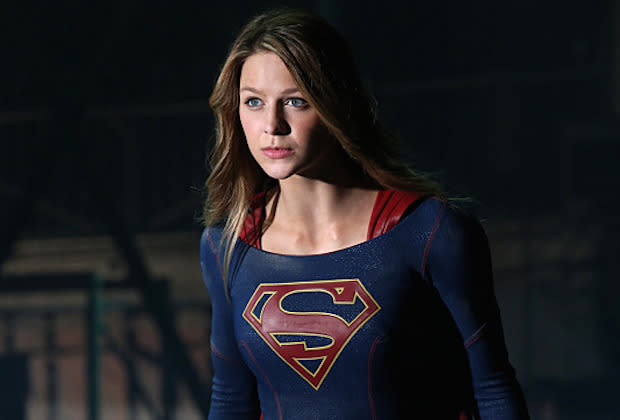Why 'Supergirl' Is The Feminist Hero TV Needs

So after months of mostly lackluster premieres, it turns out that the fall TV season has produced only one super-good network pilot: Supergirl, zooming around your screen on Monday night. It’s got the sunny colors and optimistic energy of The Flash, a bright streak of feminism coursing through its storyline, and charming, star-making performance by Melissa Benoist as Kara Zor-El, aka Kara Danvers, aka Supergirl. Plus, Jeb Bush, based on photos he’d ogled, recently called the new Supergirl “pretty hot,” so the show has already achieved the crucial election-season pop-culture goal of inspiring a Presidential-candidate gaffe — this one a super-icky gaffe.
In Supergirl, Kara Jor-El was sent to Earth from an exploding Krypton, got caught in the Phantom Zone for a few years, landed in the warm arms of humans Jeremiah and Eliza Danvers (played by Lois & Clark’s Dean Cain and the 1984 movie Supergirl, Helen Slater), and is now a twentysomething, glasses-wearing mild-mannered employee of media conglomerate CatCo, headed by the imperious Cat Grant (Calista Flockhart, camping it up nicely).
The pilot episode moves along swiftly, looking to the past (setting up Laura Benanti, who escaped from the exploding Nashville, as Kara’s mother), the present (Chyler Leigh as Alex Danvers, Kara’s super-smart step-sister), and the future (a clever montage of Kara trying on various costumes to launch her hero career before settling on a pert but sensible outfit).
Under the supervision (as opposed to Supergirl’s super-vision) of producers including Greg Berlanti, Supergirl sets up a guaranteed stable of DC Comics-based villains as it’s revealed that Kara’s Earth-bound rocket also trailed along a Kryptonian maximum security prison stocked with criminals and higher-aspiring arch-villains.
Related: Meet the Rogues Gallery of Villains on ‘Supergirl’
Berlanti and company have wisely rejected the creatively-exhausted dark/gritty/brooding/pessimistic moods and color palette that have dominated super-hero comics adaptations ever since Frank Miller and Christopher Nolan’s Dark Knight conception of Batman. Berlanti’s breakthrough in this area was The Flash, which stands in bold, favorable contrast to Arrow. Doing bright-and-hopeful with Supergirl, however, was more of a risk, since cheerful colors and a lighter tone can read as lightweight — superficial — to male-dominated consumers of this kind of entertainment.
The producers’ response has been an exhilaratingly aggressive emphasis on the outward, affirmative female gaze in Supergirl. Kara’s character is molded by her mother, Alura (her father barely registers in the pilot). Her most important Earth relationship is with her step-sister, herself a highly-valued member of the Department of Extra-Normal Operations, who’s steely enough to go toe-to-toe with her DEO boss played by 24’s David Harewood in asserting Supergirl’s value as a crime-fighter.
And most entertainingly, Flockhart’s Cat Grant serves as a vibrant example to Kara (who, like Superman’s Clark Kent, is obliged to feign timidity to protect a secret identity) of strong women in society who value their “girlishness” as a useful aspect of their core beliefs. It’s Cat who makes the pilot’s wonderfully pointed speech defending her “branding” of National City’s new hero as “Supergirl” rather than “Superwoman.” It’s a crucial argument to get across in the show’s first episode, because it opens the big-tent audience invitation that a broadcast network like CBS wants, while remaining true to the show’s core precepts: Both Cat Grant and CBS want little girls, adolescent girls, and women — as well as boys and men — to identify with this new power in the world.
Tellingly, the most problematic and sometimes downright irritating character in Supergirl is James Olsen. Where to begin? First, the name: What, the traditional “Jimmy” was too flippant, not macho enough? Then there’s his I’m-Superman’s-buddy attitude, which (while in line with comics history: The name of the comic book was, after all, “Superman’s Pal Jimmy Olsen”) compels him to condescendingly lecture Supergirl in what “The Big Guy” thinks and hopes for his super-cousin in the future. And yet this cool-dude egotist is being positioned as Kara’s crush — the least promising aspect of Supergirl by far. Mehcad Brooks does his best to invest James Olsen with charm, but he’s hamstrung by a combination of ill-thought-through character development and political correctness: It’s obvious that the producers thought their Olsen could not be seen as the excessively enthusiastic, puppy-dog-eager Jimmy Olsen portrayed in his 1960s solo comic book, or in the recently-deceased Jack Larson’s TV performance in the 1950s Superman TV series. But turning James into a smug surrogate of Superman’s superfluous guardianship of Supergirl directly contradicts the rest of this new series’ tone.
That said, Supergirl does just about everything else right. Comic-book adaptations are always problematic for television. The stories have to adhere to the comics’ mythology to please fans, yet need to be clear enough for a general audience that knows nothing about the super-hero. The special-effects need to be sophisticated enough to make a viewer believe a girl can fly, yet of necessity remain within the lower-than-feature-film budgets of weekly TV shows. Supergirl succeeds in both departments.
The challenge, as always, is whether Supergirl can keep the high standards of its pilot aloft. Right now, given its carefully conceived set-up and a couple of key, late-in-the-episode plot points that I won’t spoil, Supergirl is looking awfully promising.
Supergirl premieres on CBS Monday night at 8:30 p.m.; its regular time period will be Monday nights at 8 p.m.

